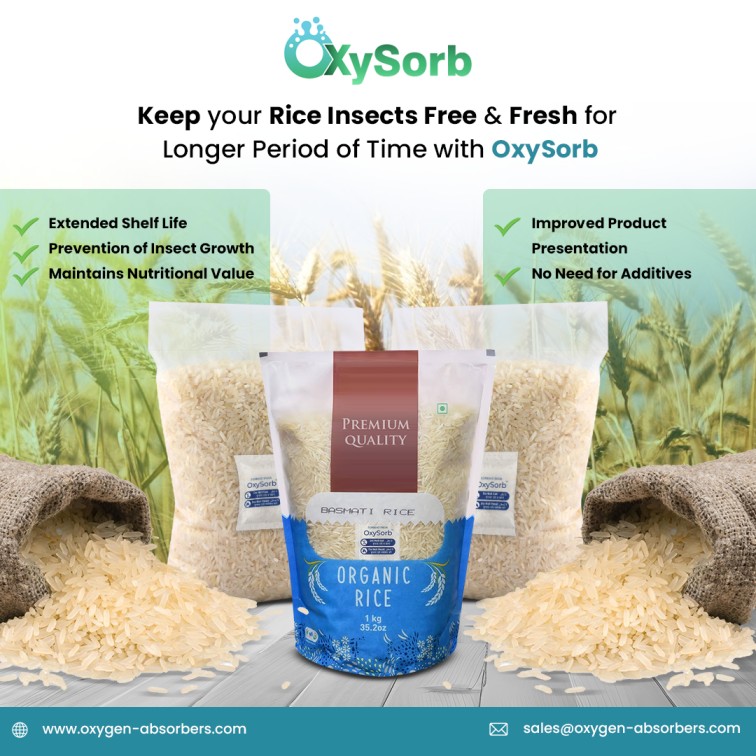In today’s highly competitive food packaging
industry, ensuring the freshness and safety of products is more crucial than
ever. One of the most effective solutions for food preservation is the use of OxySorb, the best oxygen
absorber. They help manufacturers reduce food waste and extend the shelf
life of products.
OxySorb absorbers work by eliminating residual
oxygen inside sealed packaging, which protects products from oxidative
degradation, spoilage microbes, and the loss of sensory qualities such as
colour, aroma, and texture. With decades of innovation in active packaging
technology, OxySorb oxygen absorbers are specifically designed to meet the
evolving demands of modern food packaging.
They are effective in a wide range of applications,
including baked goods, meats, cheeses, dried fruits, and rice packaging.
OxySorb plays a vital role in maintaining product integrity and enhancing food
security globally.
5 Reasons to use OxySorb Oxygen Absorbers in Food packaging
Discover the top 5 reasons to use OxySorb in
food packaging. Learn how this smart solution helps keep food fresh, reduce
waste, and extend shelf life for products like bread, meat, cheese, and more.
Perfect for boosting food safety and quality in the packaging industry.
1. Helps Food Last Much Longer
OxySorb oxygen absorbers are a powerful
way to make packaged food last much longer. They work by removing up to 99.9%
of the oxygen trapped inside sealed containers or bags. Oxygen is one of the
main reasons food goes bad—it speeds up spoilage by causing mould growth,
turning oils rancid, and breaking down the nutrients in food.
By using OxySorb, you create a safe,
low-oxygen environment that keeps foods like rice, beans, dried fruits, nuts,
coffee, and snacks fresh for far longer than normal. In some cases, especially
with dry goods stored properly in airtight packaging, the shelf life can be
extended to 10, 20, or even 30 years. This makes OxySorb a smart solution for
emergency food storage, bulk buying, or keeping pantry staples fresh for daily
use.
2. Keeps Color, Taste, and Texture
When food is exposed to oxygen, it
doesn’t just spoil faster—it also starts to lose the things that make it
enjoyable to eat. Colours fade, flavours change, and textures become dry,
chewy, or brittle. This can be especially noticeable in foods like dried herbs,
spices, snacks, teas, and dehydrated fruits.
OxySorb oxygen absorbers help prevent
these changes by keeping the oxygen levels very low. That means food holds onto
its bright colour, fresh smell, crisp texture, and full flavour, just like it
had when first packaged. This not only improves the eating experience for
customers but also helps businesses maintain a strong brand reputation by
delivering consistent product quality.
3. Stops Mould and Bacteria Naturally
Many harmful bacteria, moulds, and other
microorganisms need oxygen to grow and survive. When oxygen is present in food
packaging, these microbes can thrive, leading to spoilage, bad odours, or even
health risks. OxySorb removes oxygen down to levels as low as 0.01%, creating
an environment where these unwanted microbes cannot live or reproduce.
This method is natural and doesn’t rely
on artificial chemicals or preservatives, making it a healthier
option for food preservation. It’s especially valuable for organic and
all-natural food brands that want to keep their ingredients clean and safe
while still preventing spoilage. OxySorb is also compliant with FDA and ISO
standards, making it a trusted choice in the food packaging industry.
4. Cuts Down on Food Waste and Saves
Money
Food waste is a huge global issue.
Studies show that over 30% of all food produced ends up being wasted, much of
it due to spoilage before it even gets eaten. For both food producers and
consumers, that’s a loss of money, time, and resources.
OxySorb helps reduce this waste by
extending the time for food to stay fresh. With fewer products going bad on
store shelves or in home pantries, there’s less need to throw food away. This
saves costs for manufacturers, retailers, and households. OxySorb
is also available in a wide range of sizes, from small 20cc sachets to
large 3000cc options—making it suitable for everything from small food pouches
to large bulk storage. Its affordability adds even more value by giving great
results without breaking the budget.
5. Easy to Use in Many Packages
One of the best things about OxySorb
oxygen absorbers is how simple and versatile they are. They work with many
different types of packaging, including Mylar bags, mason jars, plastic
containers, metal tins, vacuum-sealed bags, and more.
To use, you just place the right-sized
OxySorb sachet inside the container with your food, then seal it tightly.
That’s it—no special tools or complicated steps needed. Whether you’re a food
manufacturer, a small business owner, or a home user storing dry goods, OxySorb
easily fits into your current packaging process. It’s a reliable, convenient
solution for keeping all kinds of products—like grains, herbs, snacks, pet
food, or even pharmaceuticals—safe and fresh for longer.
Wrap It Up!
OxySorb oxygen absorbers aren’t just a packaging accessory—they’re a powerful
tool for food preservation, quality assurance, and cost savings. Whether you're
a food manufacturer, retailer, or savvy home packer, using OxySorb means you’re
actively protecting your products and food from spoilage, waste, and lost
value.


.png)








